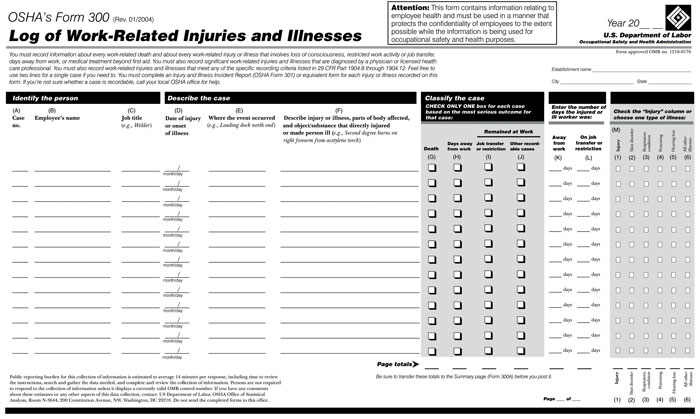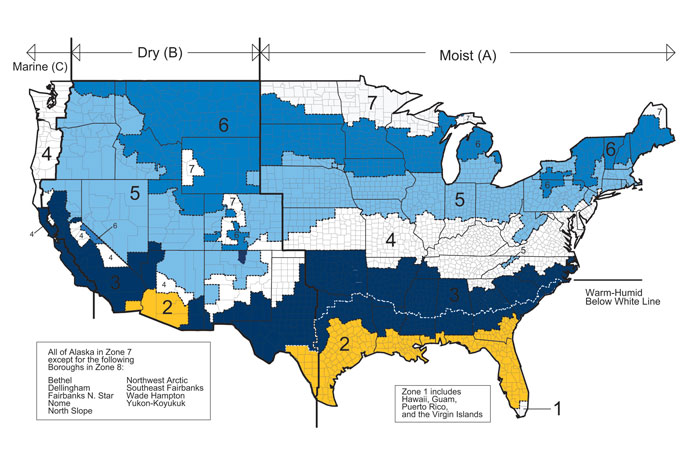OSHA proposes change to improve illness data accuracy
The Occupational Safety and Health Administration (OSHA) has proposed revising its Occupational Injury and Illness Recording and Reporting regulation by restoring a column on its Form 300, Log of Work-Related Injuries and Illnesses, to better identify work-related musculoskeletal disorders (MSDs). The rule would not change existing requirements for when and under what circumstances employers must record MSDs on injury and illness logs.
Many employers currently are required to record workplace injuries and illnesses, including work-related MSDs, on OSHA's Form 300. The proposed rule would require employers to place a check mark in a column for all MSDs they have recorded.

The proposed requirements are identical to those contained in the OSHA recordkeeping regulation issued in 2001. Before 2001, OSHA's injury and illness logs contained a column for repetitive trauma disorders that included noise and MSDs. In 2001, OSHA separated noise and MSDs into two separate columns; however, the MSD column was deleted in 2003 before the provision took effect.
"Restoring the MSD column will improve the ability of workers and employers to identify and prevent work-related musculoskeletal disorders by providing simple and easily accessible information," says David Michaels, OSHA's assistant secretary of labor. "It also will improve the accuracy and completeness of national work-related injury and illness data."
OSHA's proposal can be viewed at www.dol.gov/federalregister/msdcolumn.
In addition, as part of the Obama administration's open government policy, OSHA has made available a searchable online database that allows public access to establishment- or industry-specific injury and illness data from more than 80,000 employers from 1996 to 2007. The data is available at www.osha.gov/pls/odi/establishment_search.html and data.gov.
OSHA uses the data to calculate injury and illness incidence rates to guide its strategic management plan and focus its Site Specific Targeting Program, which it uses to target inspections.
"Making injury and illness information available to the public is part of OSHA's response to the administration's commitment to make government more transparent to the American people," Michaels says. "This effort will improve the public's accessibility to workplace safety and health data and ensure the agency can function more effectively for American workers."
Available information includes an establishment's name, address, industry, associated total case rate, days away, restricted transfer case rate and days away from work case rate. The data is specific to the establishments that provided OSHA with valid data through the 2008 data collection. The database does not contain rates calculated by OSHA for establishments that submitted suspect or unreliable data.
Data.gov provides expanded public access to valuable work force-related data generated by the federal government's executive branch. Although the Web site's initial launch provides a limited portion of the numerous federal data sets presently available, the public is invited to suggest additional data sets and site enhancements to provide better public access and use of federal data.
For more information about the Department of Labor's Open Government Web site, visit www.dol.gov/open/.
The Obama administration supports building-efficiency research
The Department of Energy (DOE), Department of Commerce (DOC), National Institute of Standards and Technology, Small Business Administration, Department of Labor, Department of Education and National Science Foundation are working together to establish a regional research center focused on developing and implementing new building-efficiency technology. The Obama administration announced the $129.7 million effort in February.
"This unique partnership will not only advance the development of new, energy-efficient technologies, it will help local governments, businesses and homeowners save money on their utility bills by putting the technology to work," says U.S. Secretary of Energy Steven Chu. "Energy-efficient buildings represent one of our best and most immediate opportunities to create jobs, save money and cut carbon pollution."
DOE will contribute as much as $22 million during the project's first year and up to $100 million during the next four years. DOC will provide as much as $5.5 million through public works and economic development funds, economic adjustment assistance funds and its Manufacturing Extension Partnership.
The agencies' efforts are intended to promote regional growth by establishing an Energy Regional Innovation Cluster, which focuses on an Energy Innovation Hub. The regional hub will develop new technologies for improved energy-efficient building systems, which will be placed in structures in the area.
Successful delegation depends on trust
Effective delegation depends on mutual trust between you and your employees. Following are tips for improving trust and making delegation a positive, productive experience:
Source: Adapted from The Manager's Intelligence Report, March issue
Details
Deryl Kratzer
What is your position within your company?
I am president of Tremco Roofing & Building Maintenance Weatherproofing Technologies Inc., Beachwood, Ohio
What is the most unusual roofing project you've performed?
Sod huts at L'anse Aux Meadows National Historic Site in Newfoundland, Canada. Vikings inhabited the huts about 1,000 years ago. A cold-applied system was installed by park enactors, offering superior waterproofing without the need to penetrate a previously installed membrane.
What was your first roofing experience?
One of my first roofing experiences was cutting cores on a JCPenney's store in 100 F weather. Despite that, I still decided to make roofing my career!
What did you want to be when you grew up?
I always wanted to be a sports broadcaster. Oh, well-now I attend as many college and professional events as my schedule allows.
If you could travel anywhere in the world, where would you go?
I would like to travel to Australia. Besides seeing the outback and other popular attractions of that beautiful country, I may even catch an Australian football game.
List three words that best describe you.
Father, husband and dependable
What three condiments are always in your fridge?
Ketchup, mustard and Miracle Whip
What is your biggest pet peeve?
Dishonesty
If you could invite any three people (dead or alive) to dinner, whom would you invite and why?
I would invite two of my heroes—Arnold Palmer for sports and Ronald Reagan for politics. The third would be Jesus Christ for the most obvious reason of all. All these conversations would be inspiring.
What are the most rewarding aspects of your job?
Our first and foremost objective is to always exceed our customers' expectations. Knowing that we have done this, hearing their feedback and reading their complimentary letters are things I look forward to every day. To provide this outstanding service, you need outstanding employees—people who are committed to getting the job done no matter what obstacles they face. Watching your employees grow by tackling these challenges is exceptionally gratifying.
What is your roofing industry involvement?
I am involved with NRCA, the Center for Environmental Innovation in Roofing, the National Roofing Legal Resource Center, ROOFPAC, RCI Inc., the Construction Specifications Institute and The Roofing Industry Alliance for Progress.
People would be surprised to know …
I was a cotton broker before I joined Tremco Roofing & Building Maintenance Weatherproofing Technologies.
Construction unemployment reaches record high
According to a recent USA Today article, the construction industry's unemployment rate has risen to 24.7 percent, the highest on record since 1976.
According to the article, the construction industry, which employs 4.3 percent of the U.S.' nonfarm employees, has accounted for almost 25 percent of all job losses during the past year. The sector has lost about 2 million jobs since the recession started, and Ken Simonson, chief economist for the Associated General Contractors of America, claims the construction industry likely will eliminate 50,000 jobs per month during the first half of 2010.
However, unemployment figures for the manufacturing sector have begun to improve, adding 11,000 jobs in January.
ASHRAE approves proposal to increase minimum R-values
The ASHRAE Standard 90.1 committee recently approved a proposal to increase the minimum required prescriptive R-values for roof and wall insulation levels in the standard's 2010 version.
According to the 2010 version of ASHRAE Standard 90.1, above-deck insulation levels for nonresidential buildings by climate zone are as follows:

ASHRAE's climate zone map
"The average commercial building is 25,000 square feet, and the vast majority of those are low-rise where the roof area is dominant," says Jared Blum, president of the Polyisocyanurate Insulation Manufacturers Association. "Clearly these increases in roof thermal performance can have an exponential impact at a time when energy security, economics and efficiency are all critical issues."
COMMENTS
Be the first to comment. Please log in to leave a comment.